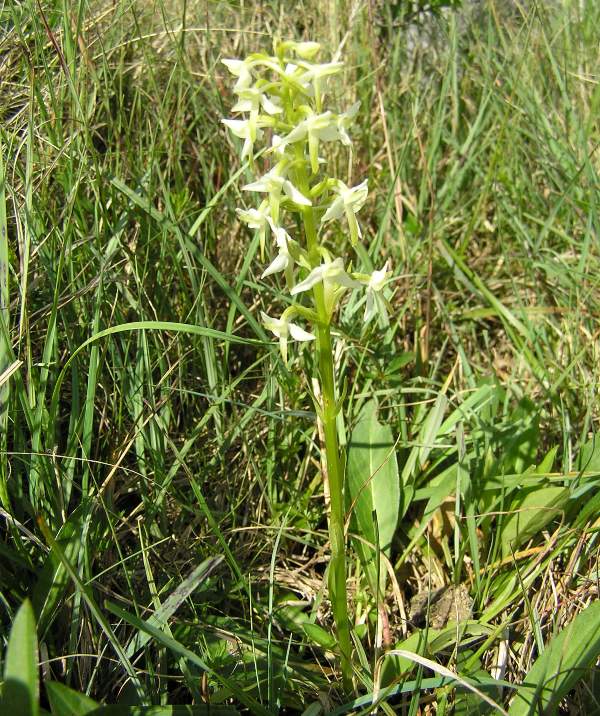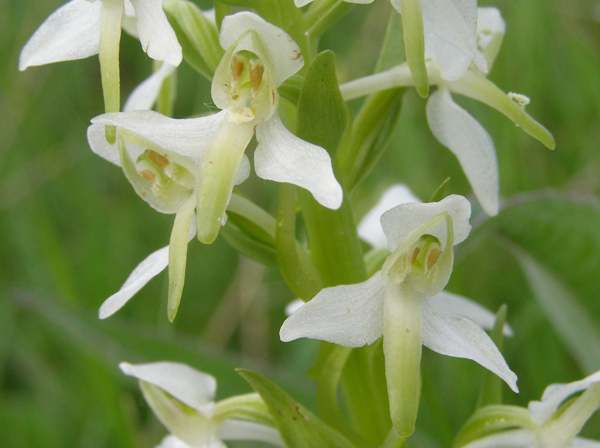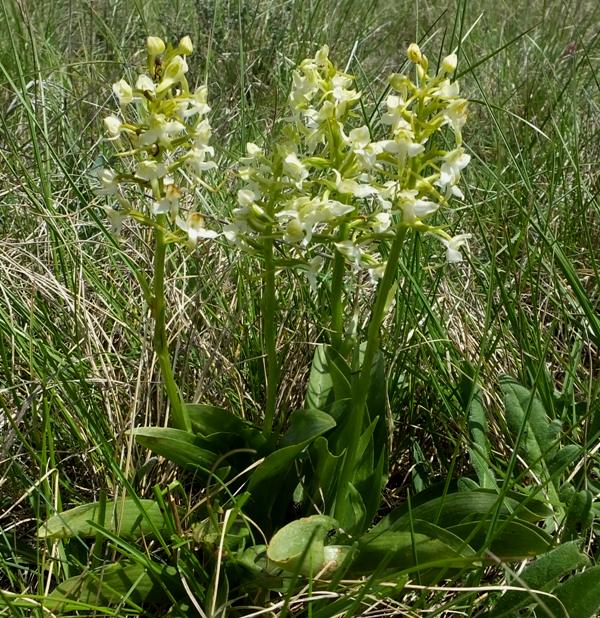Platanthera bifolia - Lesser Butterfly-orchid
Phylum: Magnoliophyta - Class: Liliopsida - Order: Orchidales - Family: Orchidaceae

The Lesser Butterfly-orchis specimen shown above was photographed in a South Wales Nature Reserve, (Cae Blaen Dyffryn,) near Lampeter in June.
Description
The Lesser and Greater Butterfly Orchids are very difficult to tell apart being similar in size despite their common names which would suggest otherwise.
Growing to between 20-30cm tall this orchid has two narrow leaves at the base of the plant with several more small bract-like leaves higher up the stem. The inflorescence is cylindrical when full open and each one carries up to 25 flower. The flowers are whiteish-green and the sepals and petals form a 'hood' above over the column. There is an elongated spur at the rear of flowers, and the lip is long and strap-like. The pollinia are white (turning brown with age) and are parallel, unlike those of the Greater Butterfly Orchid Platanthera chlorantha which form a V-shape. Close inspection of the pollinia is the only way to be certain of accurate identifcation of these two orchids.

Distribution
Lesser Butterfly Orchid is in steep decline throughout its range which includes the UK, Europe, Asia and North Africa.

Above: Platanthera bifolia plants in the Aveyron region of southern France, mid May
Habitat
This orchid occurs on heathland and in boggy ground. It also grows in woodland on calcareous substrates, and in open alkaline meadows.
Flowering times
June to the end of July.
The specimen shown above was photographed in a South Wales Nature Reserve, (Cae Blaen Dyffryn,) near Lampeter in June.
Varieties and Hybrids
A hybrid between Lesser Butterfly-orchid Platanthera bifolia and Greater Butterfly-orchid Platanthera chlorantha - Platanthera x hybrida - is rare but sometimes occurs where the two species flower together.
Etymology
The genus name Platanthera comes from Greek and means 'broad or wide anther', referring to the wide separation of the bases of the two pollinia in the Lesser Butterfly Orchid, which is the type species of the genus. (Not all Platanthera species display this charcter, however.) The specific epithet bifolia refers to the two leaves at the base of the stem.
Reference sources
The Plant List
Sue Parker (2023) Wild Orchids of Wales - how, when and where to find them; First Nature e-book (Amazon Kindle format)
Sue Parker (2023) Wild Orchids of the Algarve - where, when and how to find them; First Nature e-book (Amazon Kindle format)
Anne and Simon Harrap (2005) Orchids of Britain and Ireland; A&C Black
Pierre Delforge (2005) Orchids of Europe, North Africa and the Middle East; A&C Black
Den Nordiska Floran (1992) Bo Mossberg, Stefan Ericsson and Lennart Stenberg; Wahlstrom & Widstrand
Les Orchidees de France, Belgique et Luxemborg; Parthenope Collection
Please Help Us: If you have found this information interesting and useful, please consider helping to keep First Nature online by making a small donation towards the web hosting and internet costs.
Any donations over and above the essential running costs will help support the conservation work of Plantlife, the Rivers Trust and charitable botanic gardens - as do author royalties and publisher proceeds from books by Pat and Sue.


